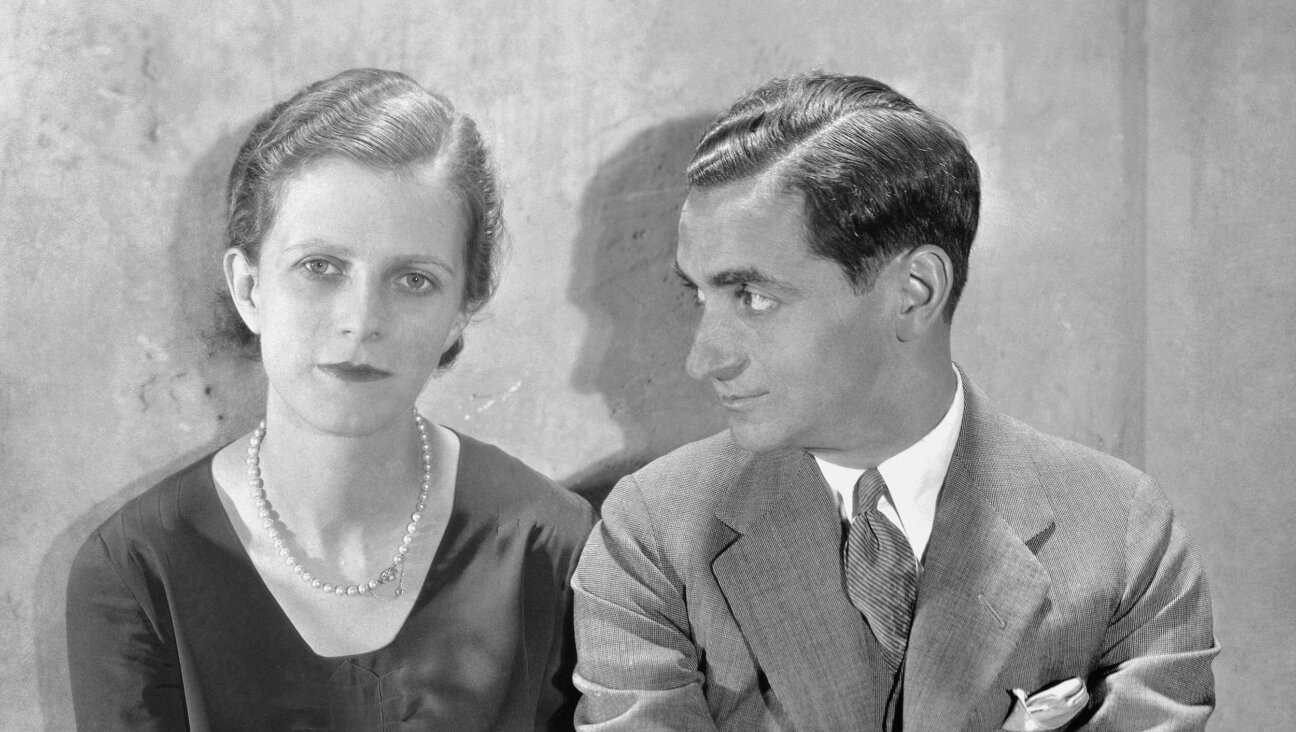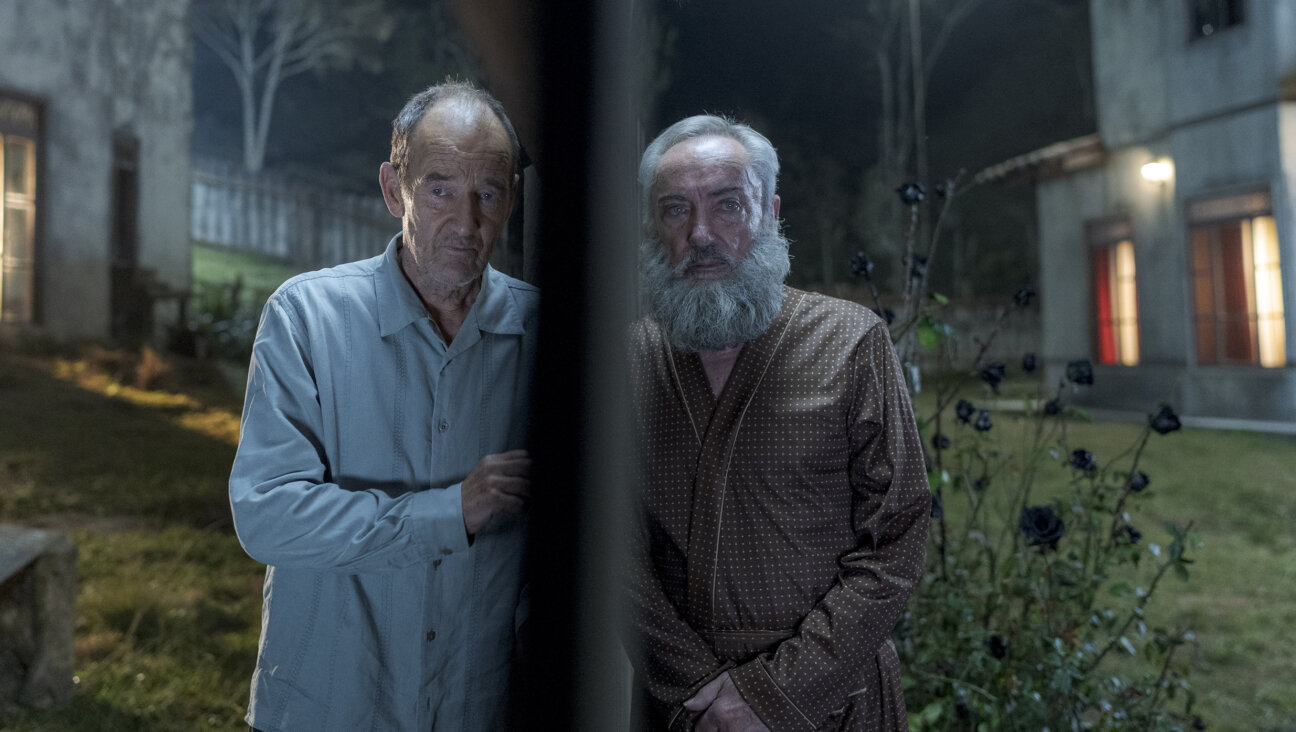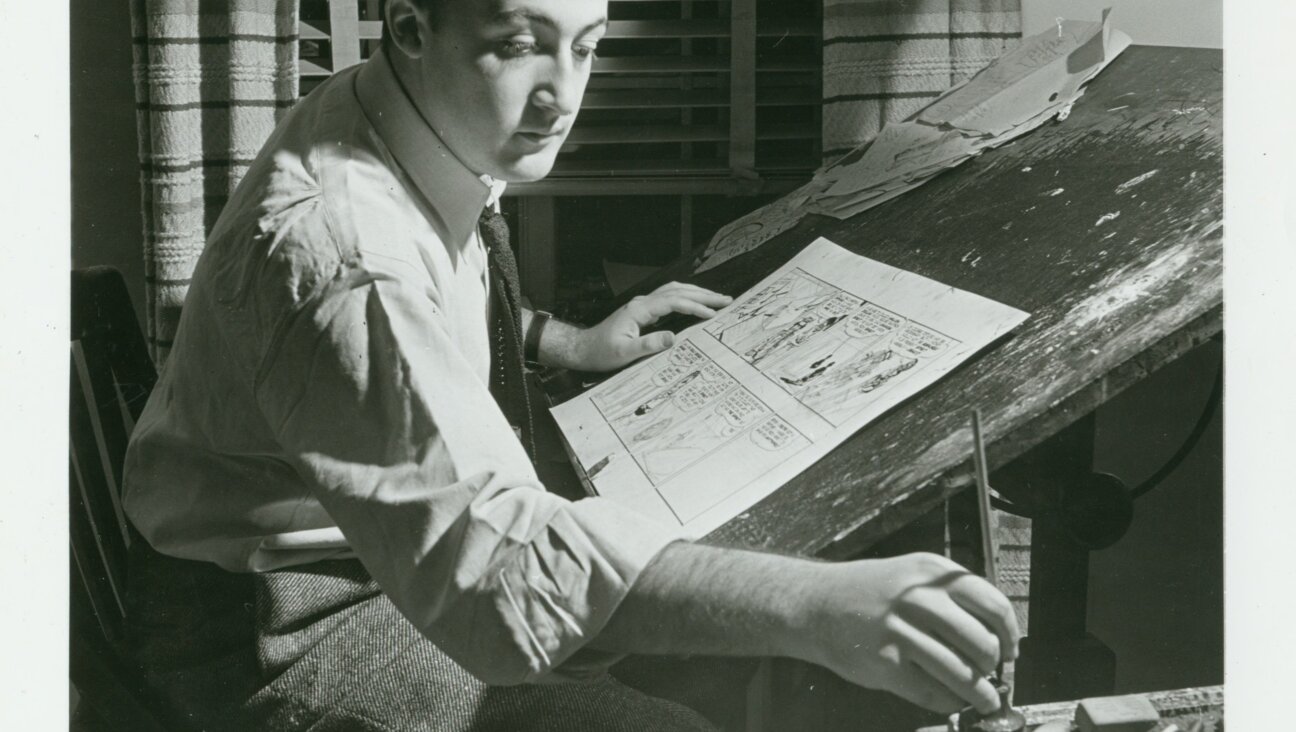The wonderful, horrible afterlife of Leni Riefenstahl

Leni Riefesntahl on set for a film in 1931. Image by PhotoQuest/Getty Images
It’s the weekend, and you’re looking for something to watch with your family. Maybe, to broaden your horizons, something directed by a woman. So you look up the best female filmmakers of all time. The same names appear on every list: Agnés Varda, Lois Weber, Sofia Coppola, Clair Denis.
And Leni Riefenstahl.
Riefenstahl, who died in 2003 at the age of 101, is best-known for her 1935 film “Triumph of the Will.” The movie, the single most famous piece of Nazi propaganda, is a populist exaltation of Adolf Hitler; it focuses nearly as much on the Führer’s devotees as on the man himself. Often cited as one of the most artistically innovative films ever made, “Triumph of the Will” has consistently been seen as a staple of the cinematic canon. It has an 87% positive critical rating on Rotten Tomatoes. In a November BBC poll of nearly 400 movie experts, it was ranked the 45th-greatest movie ever made by a woman. Riefenstahl’s “Olympia,” her 1938 documentary about the 1936 Berlin Olympics, was number 37.
The continued respect afforded to Riefenstahl’s work makes her an anomaly. A number of artists considered to be of international importance existed among or adjacent to the ranks of the Nazis, including the sculptor Arno Breker and the actor Gustaf Gründgens, yet Riefenstahl is the only one whose work is still considered not only relevant, but even admirable. The post-war history of the Nazi elite is complicated and morally fraught; Nazi scientists were exported en masse to Allied countries eager for their expertise, and certain pro-Nazi intellectuals like the philosopher Martin Heidegger retained broad spheres of academic influence. But of the creative classes, whose work was of particular concern to Hitler, few artists who worked closely with the Nazi party continued to be held in high regard after the war. Why has Riefenstahl’s legacy been so different?
Born in Berlin in 1902, Riefenstahl began her career as a dancer in the Weimar Republic, then transitioned into acting in silent movies and, briefly, talkies. She started making films in the early 1930s, as Hitler rose to power; their collaboration began after she wrote him a fan letter in 1932, but she was never a documented member of the Nazi party. After the end of World War II, during the process of denazification, she faced four trials — according to the United States Holocaust Memorial Museum — one of which resulted in her being labeled a “fellow traveler,” a designation that didn’t indicate direct cooperation. After finishing “Tiefland,” which she filmed under the Third Reich but was prevented from distributing until 1954, she did not release another film until 2002, shortly before her 100th birthday. In the intervening decades, she became a photographer most famous for her pictures of the Nuba tribes of Sudan. She died in 2003 at the age of 101.

Leni Riefenstahl and Adolf Hitler in 1937. Image by Getty Images
Beyond those bare truths, Riefenstahl’s legacy has been long contested. That was the result she wanted: Along with photography, her great post-war endeavor was crafting an autobiographical mythology that obscured her participation in the Third Reich and framed her as an unjustly denigrated genius. In the 1975 New York Review of Books essay “Fascinating Fascism,” Susan Sontag offered a clinical fact-check of the biographical information included with Riefenstahl’s critically heralded book of photographs “The Last of the Nuba.” That collection portrayed Riefenstahl as an opponent and eventual victim of the Nazis, suggesting that she “refus[ed] to submit to Goebbels’ attempt to subject her visualisation [sic] to his strictly propagandistic requirements” and that she had an “acquaintance” — not close collaboration — “with the Nazi leadership.” Sontag’s response was brisk and palpably angry. “Except for the bit about her having once been a household word in Nazi Germany,” she wrote, “not one part of the above is true.”
Sontag wrote from an enviable point of speculation: Fascism was a distant enough force, she wrote, that art echoing it was “for most people… probably no more than a variant of camp.” Her essay was a necessary rebuke to Riefenstahl’s revisionism, but Riefenstahl, capitalizing on the indifference Sontag noted, persisted in her quest, and was largely successful. She released a memoir in 1987 that was published in English translation in 1993, at the same time that Ray Müller released his documentary “The Wonderful, Horrible Life of Leni Riefenstahl,” which Riefenstahl commissioned. The New York Times hailed the film, and by proxy the book, as an“astonishing record of how [Riefenstahl] has survived,” calling her an “überachiever.” When she died, the Guardian’s obituary described her as “The first internationally acclaimed female director, [who] never escaped the shadow of her role in monumental Nazi propaganda films.” “Her skill cost her dear,” wrote The Telegraph. “Plundered by Allied propagandists, many of her images became synonymous with the Nazis, and her reputation meant that she could never make another film.”
Poor Leni! Riefenstahl’s elegists could be critical of her work and person, but they displayed a near-unilateral impulse toward sympathy, depicting her as having been in some way victimized by her relationship with Hitler. It was widely understood that she had created tremendously effective Nazi propaganda rooted in genuine affection and admiration for the Third Reich’s leader. Yet as she aged into an artistic curio, few took that charge particularly seriously. “It’s not that Riefenstahl’s Nazi past has suddenly become acceptable,” Sontag wrote. “It is simply that, with the turn of the cultural wheel, it no longer matters.”
The cultural wheel keeps turning, and a global pivot toward nationalism and authoritarianism has necessitated, for some, a reevaluation of Riefenstahl’s work. “The fear that our country may be drifting toward fascism means that appreciating the aesthetic appeal of fascist art has come to seem like a luxury I can no longer afford,” the novelist and critic Francine Prose wrote in a reassessment of Riefenstahl in the Yale Review in 2018. The real question is no longer whether we can continue to justify watching and lauding Riefenstahl’s films; it’s about what her survival, and the particular means she used to achieve it, tell us about the failures of our political and historical narrative-making. It’s about, in its own small way, how we ended up where we are now.
There are several reasons for Riefenstahl’s lasting success: The determination with which she went about reshaping the public narrative of her life, including by bringing 50-odd libel suits, many of which she won; the widespread idea that her films are so technically accomplished that their contents and purpose hardly matter; the later-20th-century fad for detaching the idea of the artist from their art, which helped foster an environment in which Riefenstahl — propagandist, friend of Hitler and knowing profiteer from the Nazi regime — could be detached from the shot-for-shot excitement of her films.
But most powerful of all is her gender. The myth she wove around herself was that of a ferociously independent and ambitious woman whose apolitical artistic brilliance was used against her when, after the fall of the Reich, she was made the scapegoat of her industry — a role for which her gender made her the natural choice.
Her creation of that narrative began with her denazification trials and a contemporaneous libel suit she brought against the magazine Revue over its extensive exposé on “Tiefland,” which features a cast of extras of Roma and Sintri heritage who were pulled directly from Nazi collection camps. Many of those extras — at least a documented 20 of 48, although the fates of others remain unaccounted for — were sent to concentration camps, where they died, directly after filming concluded. Riefenstahl, during her trials and after, was vehement that she had no knowledge of the fate that awaited the extras in the camps, and even insisted that she had seen each and every extra alive and well after the end of the war. (Despite the centrality of “Tiefland” to Riefenstahl’s denazification trials, none of the surviving extras involved were ever called to testify.)
Her insistence on her blamelessness, both in the case of “Tiefland” and under the Third Reich at large, relied on her careful depiction of herself as alienated from internal Nazi politics. She claimed, despite serious evidence to the contrary, that she’d had no part in any decisions made about the “Tiefland” extras, starting with their casting. More broadly, she insisted that the Nazi propaganda machine under Joseph Goebbels had consistently worked to obstruct and isolate her, an idea that became especially effective during the many decades when Hitler was largely believed to have functioned mostly as a figurehead. If the functional Nazi apparatus considered her an outrageous problem, how could anyone accuse her of having collaborated with it?
But her most prominent defense, which she repeated for the rest of her life, was that she was simply an artist whose profound focus left her no room to consider politics or world affairs. Historical records prove otherwise. Riefenstahl claimed to her death, for instance, that “Triumph of the Will” was an act of reportage, yet ample contemporary documentation makes clear that she was an active participant in planning the 1934 Nuremberg rally — and that the rally was planned primarily for the purpose of producing the film. But fact was never of particular interest to Riefenstahl, and she insisted that her persecution both in court and in the public eye — and the real reason she couldn’t secure funding to make films after the war — was just a way of penalizing her for being an accomplished woman, whose gender made her both more liable to attacks and less able to defend against them than her male peers.
She had some evidence on her side: Many of her male peers, most notably Veit Harlan, director of the famous Nazi propaganda film “Jüd Süss,” were able to continue making films after the war, while she was shut out from the industry. But from that outcome she spun a retroactive story of discrimination and exclusion that painted her as burdened with unjust accusations of culpability because of her sex. “Part of the impetus behind Riefenstahl’s recent promotion to the status of a cultural monument surely owes to the fact that she is a woman,” Sontag wrote.
“The myth of feminine innocence stood Riefenstahl in good stead,” wrote the pioneering feminist bell hooks in a review of Riefenstahl’s memoir, as a means by which to “deflect moral and and ethical accountability, especially in defending her complicity with the Nazi regime.”

Behind the scenes of Riefenstahl’s “Triumph of the Will”: Cameramen and lighting rigs at the 1934 Nuremberg Nazi Party Congress. Image by FPG/Getty Images
In 1999, the second-wave German feminist Alice Schwarzer published a controversial profile of Riefenstahl in which she refered to the filmmaker as the victim of a “witch-hunt.” In a 2010 interview about that piece, she said that, upon meeting Riefenstahl, “it was clear to me: above all else, she felt treated unfairly as a woman.” Steven Bach, author of the 2007 biography “Leni: The Life and Work of Leni Riefenstahl” wrote in 2002 that Riefenstahl perpetually denied “that she was Hitler’s mistress or, as one old canard has it, that she ever danced nude for him at Berchtesgaden,” but that she was also the only continuing source of those suggestions. Bach framed her commitment to those rumors as a canny way of asserting relevance via intrigue: Look, the woman who might have been Hitler’s lover! But it was a way of saying something different and more malicious, too: Look, the woman about whom they told all those awful and scandalous lies! Riefenstahl described herself as simultaneously entirely female and entirely male. The artist, she implied, was a man; the body that suffered consequences for that art, a woman.
The idea of Riefenstahl as a beleaguered woman caught on, becoming a near-universal claim not only of those who spoke in her defense, but those who tried to portray her with a measure of accuracy. Ray Müller, director of “The Wonderful, Horrible Life of Leni Riefenstahl,” at points seriously pressed Riefenstahl about the films she made for the Third Reich, and her relationship with its leader. Even so, in a 1994 interview with Cineaste, he responded affirmatively to a question about whether the decades of controversy over her had “to do with her being a woman.” “Her talent was her tragedy,” he said.
Acclaiming Riefenstahl for Time Magazine on her 100th birthday in 2002, the late critic Richard Corliss called the accusations against Riefenstahl “calumny.” Her “sin, I suspect, was being a woman,” he wrote, “a woman who, uniquely, dared to play the man’s game of filmmaking.” Jodie Foster, who in the early 2000s worked unsuccessfully to make a biopic of Riefenstahl — in which she intended to star – parroted Riefenstahl’s self-defense almost exactly: “She was not a member of the Nazi Party,” Foster said, “and she was not Hitler’s girlfriend — that’s just stupid.” In 2016, the director Stephen Hopkins was questioned about his mostly flattering depiction of Riefenstahl in his film “Race,” which told the story of Jesse Owens’s historic triumphs at the 1936 Berlin Olympics. “She found a position, in a time when women were very much second-class citizens in Germany, where she had a lot of power… She was an artist caught in the wrong place at the wrong time,” he said. In “Delayed Rays of a Star,” her 2019 novel about Riefenstahl, Marlene Dietrich and Anna May Wong, Amanda Lee Koe depicts Riefenstahl as unreliable and morally compromised. But Riefenstahl the woman-victim is there, too: “I am the scapegoat because it is easier to take your rage out on a woman, instead of the system,” she says.
Shockingly, many of these representations of Riefenstahl came after a challenge at the end of her life sharply revived her Nazi-affiliated past: A public claim by an organization advocating for Gypsies, followed by a lawsuit, which alleged that her comments refusing to acknowledge the deaths of her “Tiefland” extras were Holocaust denial. The case was dropped after Riefenstahl apologized for denying the extras’ deaths, partly on account of her age. What had looked like the start of a late accounting with Riefenstahl’s role in the Third Reich was cut short, one of the many happenstances that allowed public admiration for her to continue with relative ease.
The result of all this was a sleight-of-hand redirection of attention away from the ideology of Riefenstahl’s films. The suggestion, as it developed over time, was simple: Her struggle to succeed in a system arrayed against her due to her gender was of so much value as to negate the effect of what she produced, or the intent with which she produced it. That is, in fact, itself a sexist argument: It suggests that the harm that Riefenstahl created meant less, because she had to work against a biased system to create it.
In using her gender to propagate her personal myth, Riefenstahl showcased society’s impulse to treat certain women’s crimes, like their accomplishments, as insignificant. But she was also reworking one of the narratives that had led the Nazis to power: That of the underdog, taken advantage of by broad cultural and political changes, fighting back. Hitler gave that spin to Germany’s woes: For him, the country was an innocent preyed on by malicious, greedy others — Jews — exploiting it for their own enrichment. Riefenstahl, after the fall of the Third Reich, took that story and made it personal.
At the start of “The Wonderful, Horrible Life of Leni Riefenstahl,” Riefenstahl — nearing 100, smiling, vibrant in a blue wetsuit with yellow stripes down its arms — is scuba diving. She reaches for a particularly gorgeous fish, her body taut with wonder. Intercut with that scene are clips of her films of Hitler and the Nazis; a brief behind-the-scenes glimpse of her at work on her Third Reich documentaries; then footage of her dancing, camera balanced on her shoulder, in Africa.
The Nazi-era clips are in black and white, and the rest in color. The aesthetic message is clear. On one hand is the past, a grim, remote place in which Riefenstahl was a marginal figure. On the other is the free and joyful present, in which Riefenstahl, taking profound pleasure in life in its variety, has taken her place in the center of the frame. In two minutes, the film has cued its viewer to see the story of Riefenstahl’s life as that of a woman, fundamentally drawn to beauty and empathy, who overcomes the totalitarian pressures of her past to find herself.

Mourners sign a condolence book at Riefenstahl’s March 12, 2003 funeral in Munich. Image by JOERG KOCH/Getty Images
Narratives are flexible, and the right mix of determination and allure can twist the story of a person away from truth and toward glamour. (When architect-turned-Nazi minister Albert Speer released a memoir in 1970 after serving his 20-year sentence for war crimes, historian John Toland hailed him in The New York Times as “the most responsible member of Hitler’s lieutenants, a man who appeared to be as decent as he was intelligent.”) As the savvy narrative of unjust exploitation that fueled Riefenstahl’s resurgence once more grows in popularity — see the nationalist rallies around the globe that echo it — her success at obscuring a clearly documented history of political malfeasance has a new and urgent relevance. It shows how tremendously effective revisionism can be when employed by the right avatar, and how enthusiastic the public can be to embrace it: to see the self-fulfilled, awestruck woman in the deep blue sea instead of the Nazi collaborationist behind the camera.
Riefenstahl’s success also lays bare one of our great cultural and political failings. It didn’t take long for the narrative of World War II to be cemented as one of hard-won and complete success. Why continue the fight against mostly-obliterated fascism when a new enemy — communism — was so newly prominent? Why see the cultural objects that helped popularize Hitler’s creed as anything other than interesting relics? Riefenstahl was able to recraft her story because much of the world was convinced that the past was fully past. Her myth has always been the myth of WWII writ small. Her public survival has been the most prominent cultural warning that the belief that a political creed could tear apart a world, then quietly recede never to be seen again, is a tragic fantasy.
“Triumph of the Will” runs for almost half an hour before its first mention of racial purity, the central tenet of Nazi ideology. It’s more than enough time to be swept up by what the film’s Amazon Prime page appreciatively calls its “paganistic joy” — ardent and innocent faces, a powerful sense of hope. It’s tremendously appealing, so much so that when the toxicity behind the beauty begins to show itself, bit by bit, you barely notice. Riefenstahl really was a master of her craft: Her life, as her art, was a work of extraordinary propaganda. In both, she knew that her audience wanted, no matter how much they protested otherwise, to be deceived.















